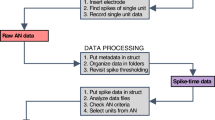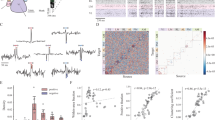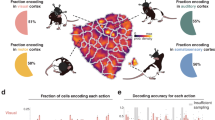Abstract
A computational model is described in which the sizes of variables are represented by the explicit times at which action potentials occur, rather than by the more usual 'firing rate' of neurons. The comparison of patterns over sets of analogue variables is done by a network using different delays for different information paths. This mode of computation explains how one scheme of neuroarchitecture can be used for very different sensory modalities and seemingly different computations. The oscillations and anatomy of the mammalian olfactory systems have a simple interpretation in terms of this representation, and relate to processing in the auditory system. Single-electrode recording would not detect such neural computing. Recognition 'units' in this style respond more like radial basis function units than elementary sigmoid units.
This is a preview of subscription content, access via your institution
Access options
Subscribe to this journal
Receive 51 print issues and online access
$199.00 per year
only $3.90 per issue
Buy this article
- Purchase on SpringerLink
- Instant access to full article PDF
Prices may be subject to local taxes which are calculated during checkout
Similar content being viewed by others
References
McClurkin, J. W., Optician, L. M., Richmond, B. J. & Gawne, T. J. Science 253, 675–677 (1991).
Bialek, W. & Rieke, F. Trends Neurosci. 15, 428–434 (1992).
Atick, J. J. Network 3, 213–251 (1992).
Perkel, D. H. & Bullock, T. H. Neurosci. Res. Prog. Bull. 6, 221–248 (1968).
Bullock, T. H. A. Rev. Neurosci. 16, 1–15 (1993).
Burgess, N., O'Keefe, J. M. & Recce, M. in Advances in Neural Information Processing Systems Vol. 5 (eds Hanson, S. J., Giles, C. L. & Cowan, J. D.) 929–936 (Morgan Kaufman, San Mateo, CA, 1993).
Heiligenberg, W. F. Neural Nets in Electric Fish 51–60 (MIT Press, Cambridge, MA, 1991).
Reichardt, W. Z. Naturf. 12b, 448–457 (1957).
Carr, C. E. & Konishi, K. J. Neurosci. 10, 3227–3246 (1990).
Kauer, J. S. Trends Neurosci. 14, 79–85 (1991).
Herz, J., Krogh, A. & Palmer, R. G. Introduction to the Theory of Neural Computation (Addison Wesley, Redwood City, CA, 1991).
Alonso, A. & Llinas, R. R. Nature 342, 175–177 (1989).
Silva, L. R., Amital, Y. & Connors, B. W. Science 252, 432–435 (1991).
Shepherd, G. M. & Brayton, R. K. Brain Res. 175, 377–382 (1979).
Rodieck, R. W. The Vertebrate Retina (Freeman, San Francisco, 1973).
Tank, D. W. & Hopfield, J. J. Proc. natn. Acad. Sci. U.S.A. 84, 1896–1900 (1987).
Kuwabara, N. & Suga, N. J. Neurophysiol. 69, 1713–1724 (1993).
Unnikrishnan, K. P., Hopfield, J. J. & Tank, D. W. IEEE Trans. Signal. Process 39, 698–713 (1991).
Adrian, E. D. J. Physiol., Lond. 100, 459–473 (1941).
Shepherd, G. M. The Synaptic Organization of the Brain 152–183 (Oxford Univ. Press, Oxford, 1979).
Haberly, L. Chem. Senses 10, 219–238 (1985).
Nickell, W. T. & Shipley, M. T. in Science of Olfaction (eds Serby, M. J. & Chobor, K. L.) 172–212 (Springer, New York, 1992).
Laurent, G. & Naraghi, M. J. Neurosci. 14, 2993–3004 (1994).
Delaney, K. R. et al. Proc. natn. Acad. Sci. U.S.A. 91, 669–673 (1994).
Tank, D. W., Gelperin, A. & Kleinfeld, D. Science 265, 1819–1820 (1994).
Shepherd, G. M. The Synaptic Organization of the Brain 289–307 (Oxford Univ. Press, Oxford, 1979).
Eckhorn, R. et al. Biol. Cybern. 60, 121–130 (1988).
Gray, C. M. & Singer, W. Proc. natn. Acad. Sci. U.S.A. 86, 1698–1702 (1989).
Carr, C. E. & Konishi, M. Proc. natn. Acad. Sci. U.S.A. 85, 8311–8315 (1988).
Harnischfeger, G., Neuweiler, G. & Schlegel, P. J. Neurophysiol. 53, 89–109 (1985).
Revial, M. F., Sicard, G., Duchamp, A. & Holley, A. Chem. Senses 7, 175–190 (1982).
Girosi, F. & Poggio, T. Biol. Cybern. 63, 169–176 (1990).
Hossam, O. & Fahmy, M. M. Neural Computat. 6, 927–943 (1994).
Author information
Authors and Affiliations
Rights and permissions
About this article
Cite this article
Hopfield, J. Pattern recognition computation using action potential timing for stimulus representation. Nature 376, 33–36 (1995). https://doi.org/10.1038/376033a0
Received:
Accepted:
Issue date:
DOI: https://doi.org/10.1038/376033a0
This article is cited by
-
Robust encoding of natural stimuli by neuronal response sequences in monkey visual cortex
Nature Communications (2023)
-
Chimera state in a feed-forward neuronal network
Cognitive Neurodynamics (2023)
-
Adaptive Fuzzy Population Coding Method for Spiking Neural Networks
International Journal of Fuzzy Systems (2023)
-
Influence of inhibitory autapses on synchronization of inhibitory network gamma oscillations
Cognitive Neurodynamics (2023)
-
A Survey of Encoding Techniques for Signal Processing in Spiking Neural Networks
Neural Processing Letters (2021)




Celestine P. Lawrence
I employed an approximation of this algorithm to outperform a deep learning method (ref: https://openreview.net/foru... ). That is to my knowledge the first empirical demonstration on a real-life dataset "in the wild" where a signal processing method to solve the analog match problem outperforms other machine learning methods. Kindly let me know if you are aware of any other earlier demonstrations. Hopfield's illustrative demonstration is from a pre-designed dataset, and thus does not qualify.